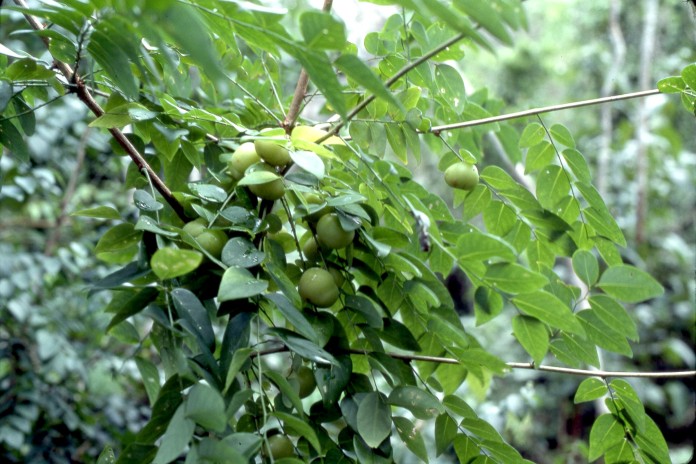A new study by researchers at the University of Leeds, United Kingdom (UK), has shown why a plant that is only found in some African countries including Nigeria could hold a key to killing renal (kidney) cancer cells.
The research was published in the chemistry journal Angewandte Chemie and was conducted in cell lines developed from cancer patients.
Phyllanthus engleri, also known as spurred phyllanthus, is found in Tanzania, Zambia, Malawi, Zimbabwe and Mozambique.
But a close relative in Nigeria, Phyllanthus niruri is commonly called stonebreaker, also known as ‘Chanca piedra’ belongs to the family Euphorbiaceae. Phyllanthus niruri is similar to Phyllanthus amarus and Phyllanthus engleri, which also belongs to the same family.
In Nigeria, it is called enyikwonwa and ngwu in the Ibo, oyomokeso amanke edem in Efik, geeron-tsuntsaayee (bird’s millet) in Hausa, and ehin olobe and yin-olobe in Yoruba.
Whole plants have been used in traditional medicine for treatment of jaundice, asthma, hepatitis and malaria. It has a potent free radical scavenging activity and could scavenge superoxides, hydroxyl radicals and can inhibit lipid peroxides.
Previous studies have shown that the plant contains a chemical, Englerin A, which kills renal cancer cells – but they have not shown why.
A research team led by Prof. David Beech, of the School of Medicine at the University of Leeds, has discovered that Englerin A in very small amounts activates a particular protein, TRPC4, and its close relative TRPC5. This triggers changes in the renal cancer cell, which kills it.
The genus Phyllanthus is one of the most widely distributed plants throughout the Amazon rainforests as well as other tropical and subtropical regions. Numerous research studies on Phyllanthus species began in the late 1980’s with the clinical efficacy of Phyllanthus niruri against viral Hepatitis B being observed. P. niruri, locally known as “Dukung Anak” in Malaysia, is originated from India. Phyllanthus can now be found in almost every tropical countries due to its wide medicinal usages and lack of toxicity.
Various therapeutic properties of this genus have been reported, including being anti-hepatotoxic, antilithic, antihypertensive, and most recently anti-Human Immuno-deficiency Virus (HIV) as well. There are also some speculation on the anti-carcinogenic activity of various Phyllanthus plants. For example P. emblica has demonstrated growth inhibitory activity on A549 and HepG2 (liver carcinoma), while the toxicity of P. polyphyllus on MCF-7, HT-29 (colon adenocarcinoma), and HepG2 was reported.
In another study, Phyllanthus was demonstrated to inhibit the growth of PC-3 (prostate adenocarcinoma) and MeWo (melanoma) via cell cycle arrest and apoptosis induction.
Until now, inhibition of cancer cell proliferation and induction of apoptosis have been thought as the markers to evaluate the effectiveness of anticancer drugs or cancer chemopreventive agents. Therefore, most of the currently available natural product-derived chemotherapeutic drugs kill cancer cells primarily by inducing apoptosis. Since malignancy of tumors is often attributed to their invasive and metastatic ability, a chemotherapeutic agent that only possesses the ability to induce apoptosis may not be useful against this type of tumours.
According to a recent study published in PLOS ONE titled “Antimetastatic Effects of Phyllanthus on Human Lung (A549) and Breast (MCF-7) Cancer Cell Lines,” current chemotherapeutic drugs kill cancer cells mainly by inducing apoptosis. However, they become ineffective once cancer cell has the ability to metastasize, hence the poor prognosis and high mortality rate.
The study evaluated the anti-metastatic potential of Phyllanthus (P. niruri, P. urinaria, P. watsonii, and P. amarus) on lung and breast carcinoma cells.
The study assessed the antimetastatic activity of Phyllanthus plants on two cancer cell lines (MCF-7 and A549). Prior to that, cytotoxic effects of Phyllanthus on the cancer cells were thoroughly screened in order to choose a non-toxic effective dose. Subsequently, the relationship of this antimetastatic effect with probable involvement of apoptosis was investigated.
The researchers concluded: “The presence of polyphenol compounds in the Phyllanthus plant is critically important in the inhibition of the invasion, migration, and adhesion of cancer cells, along with the involvement of apoptosis induction. Hence, Phyllanthus could be a valuable candidate in the treatment of metastatic cancers.”
Another study published in Asian Pacific Journal of Cancer Prevention titled
“Anti-tumor activity of Phyllanthus niruri (a medicinal plant) on chemical-induced skin carcinogenesis in mice” concluded: “The results thus suggest that P. niruri extract exhibits significant anti-tumor activity, which supports the traditional medicinal utilization of this plant.”
The researchers noted: “Chemoprevention is an important strategy to control the process of carcinogenesis. The potential of using medicinal herbs as cancer chemopreventive nutraceuticals and functional food is promising. Thus, there is a need for exploring drugs/agents, which act as chemopreventive agents. Phyllanthus niruri is a well known medicinal plant, which has been used in Ayurvedic medicine as hepato-protective, antiviral, antibacterial, analgesic, antispasmodic and anti-diabetic.
“The present study was carried out to evaluate the anti-tumor activity of a hydro-alcoholic extract of the whole plant, in seven to nine week old male Swiss albino mice, on the two stage process of skin carcinogenesis induced by a single topical application of 7, 12-dimethylbenz (a)anthracene (100 microg/100 microl acetone) and two weeks later promoted by repeated application of croton oil (one per cent in acetone/three times a week) till the end of experiment (16 weeks).
“The oral administration of P. niruri at a dose of 1000 mg/kg/b.wt. at peri- (that is seven days before and seven days after DMBA application) and post- (that is starting from the croton oil application) initiational phase of papillomagenesis caused significant reduction in tumor incidence, tumor yield, tumor burden and cumulative number of papillomas as compared to carcinogen-treated controls. Furthermore, the average latent period was significantly increased in the PNE treated group.”
Beech said: “This unexpected discovery is exciting because it means we could develop new cancer drugs towards these particular proteins, TRPC4 and TRPC5.
“Englerin A is particularly interesting because it is selective – it only kills renal cancer cells and a few other types of cancer cell. Other cell types are resistant to it, so we think Englerin A has a great deal of potential.
“This is just the first step on a journey though – our studies have been in the laboratory, not on patients. It could take some years to develop a drug which would effectively target these renal cancer cells in people.”
The research showed that the protein activated by Englerin A forms channels that open to allow tiny electrically-charged atoms known as ions to enter cells and trigger changes. This import of ions was studied at a molecular level.
Beech’s team worked with colleagues at the Max Planck Institute of Molecular Physiology in Dortmund and Freie Universität in Berlin, Germany, on the research.
Co-author Prof. Herbert Waldmann, Director at the Max Planck Institute, said: “Renal cancer is a devastating disease crying out for novel and innovative therapeutic approaches. The discovery of how Englerin A works and its protein target gives hope that new opportunities for treating this cancer can be found.
“Ion channels have hardly been explored in renal cancer and the enigmatic TRPC channels have not been considered in drug discovery for its treatment at all.
“Finding this truly novel and innovative target was only possible because we united the expertise of three groups bridging chemistry, chemical biology and biology.”
The research team will now work with the Dortmund-based Lead Discovery Center, which offers professional support in drug development, on the next stage of the project.
The Phyllanthus engleri is named after Professor Heinrich Gustav Adolf Engler (1844-1930), former Director of the Royal Botanical Gardens in Berlin, who initiated extensive botanical exploration in Africa. Some parts of the plant are used as food or in traditional therapies whereas other parts may be toxic.
A study in 2008, by Ratnayake et al in the journal Organic Letters, was the first to discover that Englerin A selectively killed renal cancer cells.
In its native habitat in southern Africa, Phyllanthus engleri has long been known to have medicinal properties. The shrub or small tree, which was formerly classified as belonging to the spurge family, is most commonly found in the dry savannahs of Tanzania, Zambia, Malawi, Zimbabwe, Mozambique and South Africa. In Tanzania, for example, the plant’s roots are used to treat epilepsy, and chewing the leaves and fruits is said to alleviate coughs and stomach aches. A decoction made from the roots is even said to be effective against bilharziosis and gonorrhoea. At the same time, the plant also contains strong toxins that can cause lethal poisoning.
In 2009, American scientists isolated more than 30 substances found in Phyllanthus engleri and tested their efficacy on cancer cells. They discovered that a specific type of compound taken from the bark of the tree – a variant known as (–)-englerin A – is particularly effective against renal cancer cells and some other forms of cancer. That same year, the group led by Mathias Christmann, who now conducts research at the Freie Universität Berlin, synthesised this complex compound. The precursor they used is the primary constituent in the essential oil of catnip (Nepeta cataria): nepetalactone – a substance that causes cats to lapse into a state of ecstasy. Nepetalactone is therefore a renewable raw material extracted from a plant that is more readily available than Phyllantus engleri. This is decisive for the further use of englerin A, as it means that larger amounts of the substance can be produced.
However, exactly how englerin A kills cancer cells remained a mystery. Until recently, it was believed that englerin A might target a variant of the enzyme protein kinase C. The Max Planck scientists have now discovered though that cells that respond to englerin A particularly well do not contain this type of enzyme at all. Instead, the researchers focused on a family of calcium channels known as TRPCs (canonical transient receptor potential channels), which are found in the membranes of renal cells.
Different renal cancer cells form different numbers of these channels. The measurements showed that adding englerin A causes the calcium concentration inside these cells to rise so significantly that the cells die within a few minutes. “We studied cancer cells that produce a lot of TRPC4. These cells are particularly sensitive to englerin A. In cells that do not produce any TRPC4 or only produce normal amounts, the calcium levels do not rise as much. Therefore, these cells don’t die,” explains Slava Ziegler from the Max Planck Institute of Molecular Physiology. However, the researchers still do not know whether the overproduction of TRPCs is the sole cause of the dying off of the cancer cells.
Englerin A thus acts specifically on cancer cells in the kidney. “This property gives the substance a major advantage over other anti-cancer drugs, because it means the side effects afflicting healthy cells could possibly be prevented,” says Herbert Waldmann from the Max Planck Institute in Dortmund, where, among other topics, he conducts research into the use of naturally occurring substances in the development of active agents.
Together with the Lead Discovery Center in Dortmund, the researchers now want to determine whether englerin A is suitable as an anti-cancer drug. The Center, which was founded by the Max Planck Society, helps bring potential active agents from basic research to clinical trial. “Englerin A is a prime example of an active substance that harbours great potential, but also a significant risk. In the current phase there would be hardly any commercial partners willing to provide the funding for further studies. The Lead Discovery Center can bridge this gap between basic research and medicine,” says Waldmann.
Herbal combo may provide novel ‘cure’ for breast cancer
Bioactive flavonoids isolated successfully from Touch Me Not (Mimosa pudica), Aloe vera and Phyllanthus niruri may provide the much sought after cure for breast cancer.
India researchers from Kannur University, Kerala, India, in a study published in the International Journal of Pharmacy and Pharmaceutical Sciences found that flavonoids isolated from Aloe vera, Mimosa pudica and Phyllanthus niruri showed cytotoxicity activity against human breast carcinoma cell line (MCF-7) and the inhibitory concentration at 50 per cent growth (IC50) was found to be, Mimosa pudica, Aloe vera and Phyllanthus niruri.
The study is titled “A comparative evaluation of anticancer activities of flavonoids isolated from Mimosa pudica, Aloe vera and Phyllanthus niruri against human breast carcinoma cell line (MCF-7) using MTT assay.” The researchers concluded: “The results indicated the cytotoxicity activity of all the three flavonoids isolated.
Therefore, they can be effectively employed in anticancer treatment. Cytotoxic study suggested that flavonoid from Mimosa pudica has the maximum cytotoxic effect than flavonoid from Aloe vera and Phyllanthus niruri against MCF-7, Human breast cancer cell line (Mimosa pudica >Aloe vera >Phyllanthus niruri).
So the findings of this study could be considered as valuable information for the use of medicinal natural products in cancer treatment. Molecular level studies and investigations to characterize and elucidate the structure of the active principle behind the activity are under progress.”
Mimosa pudica is a small or middle sizes tree about 1.5 metre in height with leaves are very sensitive, both pinnae and leaflets folding when touched. It belongs to Fabaceae family. It is reported to contain alkaloid, glycoside, flavonoids and tannins.
The Guardian






